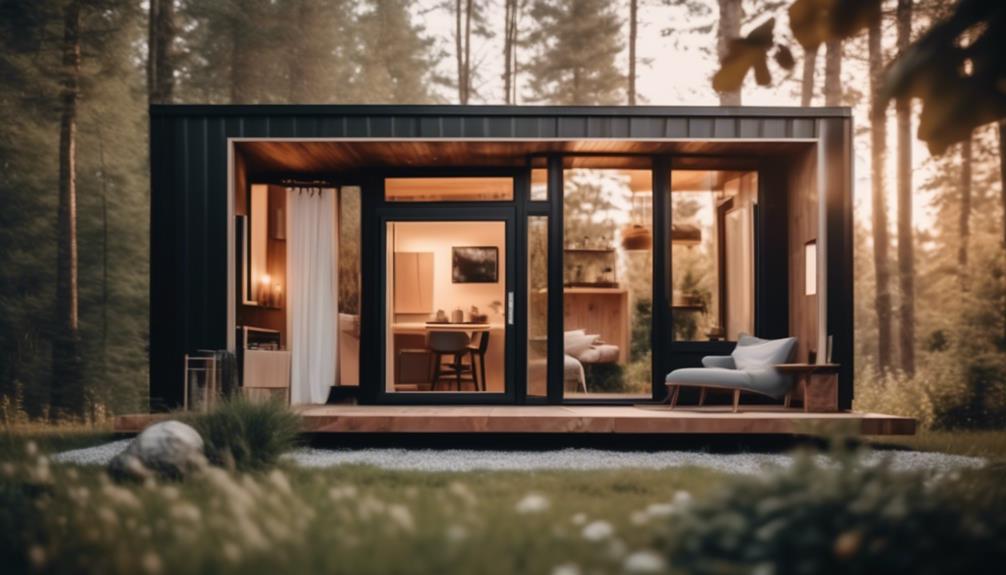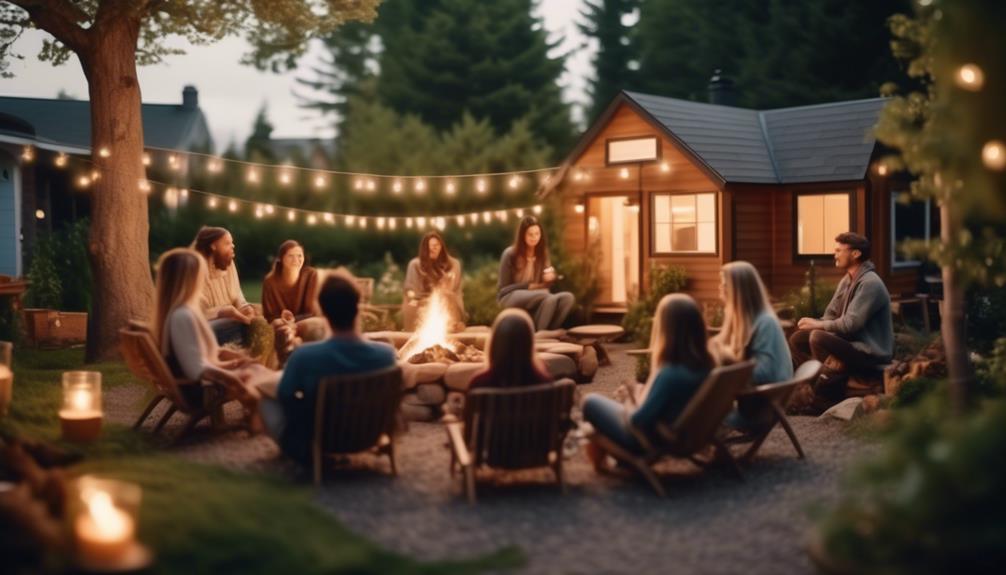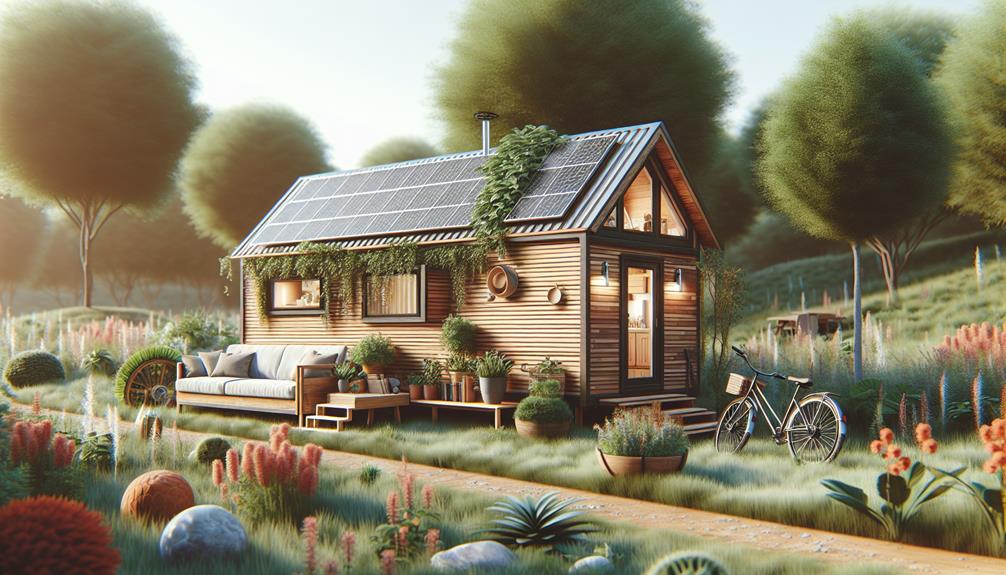Imagine you've just met Sarah, a graphic designer who halved her living expenses by moving into a sleek, custom-built tiny home. As you contemplate the potential of joining the tiny home movement, consider the myriad of advantages it presents.
You're not just buying a downsized space; you're investing in a lifestyle that champions financial freedom, reduced environmental footprint, and an emphasis on experiences over possessions. The allure of such simplicity is undeniable, but it's the practical benefits that might tip the scales for you.
You've seen the glossy photos of petite dwellings nestled in picturesque landscapes, yet there's more to uncover about how a tiny home could revolutionize your everyday life. With an open mind, explore how embracing less could indeed offer you more.
Key Takeaways
- Financial Benefits: Tiny homes offer a more affordable lifestyle with lower costs for construction, utilities, and furnishings. They allow for saving money and avoiding large mortgages, promoting economic freedom.
- Environmental Impact: Living in a tiny home reduces energy consumption, lowers carbon footprint, and encourages sustainable construction with fewer materials. Composting toilets also contribute to water conservation and reduced sewage output.
- Simplified Living: Tiny home living prioritizes simplicity and essential needs, leading to less clutter, streamlined daily routines, and reduced stress. It promotes a decluttered space and life.
- Design and Customization: Tiny homes offer a range of customization options, including eco-friendly materials and high-end finishes. Custom designs can meet legal requirements for tiny house communities, and ingenious solutions maximize space in small houses.
Financial Savings
Opting for a tiny home can lead to considerable financial savings, with the average cost ranging from $30,000 to $60,000, far below that of a standard-sized house. By choosing to build a tiny home, you're not just downsizing your living space; you're also adopting a much more affordable lifestyle.
Fewer materials and less stuff mean that the money you save isn't just on the initial purchase—it extends to the cost of living. With tiny homes cost in mind, you'll find that utilities are cheaper, and furnishing your space costs a lot less.
This innovative living solution allows you to save money, avoid large mortgages, and build up your savings. Embrace the tiny home movement, reduce your financial burden, and reclaim your economic freedom.
Environmental Impact
While you're trimming your budget with a tiny home, you're also doing your part for the planet, as these minimalist abodes have a significantly reduced environmental impact. Embracing tiny home living means you'll:
- Consume less energy due to limited space, lowering your carbon footprint.
- Use fewer building materials, which is a nod to sustainable construction.
- Potentially incorporate a composting toilet, reducing water usage and sewage output.
Your choice to live in fewer square feet doesn't just reflect a personal lifestyle change; it's a commitment to eco-friendly practices. The small size of a tiny home directly translates to a smaller ecological footprint. You're not just downsizing your living area, you're upscaling your contribution to preserving the environment, proving that innovation isn't always about having more, but often about managing with less.
Simplified Living

Embracing a tiny home means you're choosing a lifestyle that's centered around simplicity, prioritizing essential needs and creative use of space over excess. Tiny home living inherently means less clutter, as less space drives you to consider the value of each item you own. There's no room for unnecessary possessions; every object must earn its keep, often serving multiple purposes or fitting neatly into ingeniously designed extra storage space.
Tiny Living isn't just a trend; it's a philosophy that streamlines your daily routine, focusing on simplified living. With less time spent on maintenance and cleaning, you'll find yourself with significantly less stress and more time to enjoy life. By living in a tiny, you're not only decluttering your space, but also your life, leading to small house living with a large and enriching personal freedom.
Design and Customization
Your tiny home can be a tailored sanctuary, expertly designed to fit your personal style and functional needs with a range of customization options. Tiny home living is about innovation, making the most of less space without compromising on luxury. When you choose to buy or build, design and customization are at the forefront, ensuring every square inch of your living space is exactly how you dreamt it to be.
- Building Materials: Select from eco-friendly options to high-end finishes to reflect your values and aesthetics.
- Codes and Zoning Laws: Navigate through regulations with custom designs that meet legal requirements for a tiny house community.
- Maximizing Space: Ingenious solutions turn tiny houses that are small into remarkably efficient homes.
Embrace the freedom to create your dream tiny house, a true representation of your individuality and aspirations.
Community and Lifestyle

After designing a tiny home that reflects your unique style, you'll also discover the enriched community and lifestyle that comes with living in closer quarters. Tiny home living isn't just a trend that's sweeping the United States; it's a transformative living situation.
With less space, you're encouraged to spend more time outdoors and with friends and family, fostering stronger connections. Shared spaces in tiny house communities aren't just practical—they're social hubs where you can collaborate and connect.
Choosing to live in a tiny home means embracing a lifestyle that values community over square footage. You'll have more free time, since there's less to maintain, and you'll enjoy the flexibility to move around, deepening your ties with a like-minded community that cherishes the same innovative and sustainable values.
Frequently Asked Questions
What Are the Benefits of Tiny Homes?
You'll enjoy sustainable living with space efficiency and a minimalist lifestyle. Tiny homes offer lower emissions, creative designs, and mobility freedom. They foster community culture, require simplified maintenance, reduce clutter, and utilize eco-friendly materials.
What Are the 3 Negative Features of a Tiny House?
You'll face space constraints, limited storage, and zoning challenges in a tiny house. Downsizing requires sacrificing much, while minimal privacy, investment risks, and lifestyle adjustments are significant. Expect reduced amenities and potential resale concerns.
Is It a Good Idea to Buy a Tiny House?
Buying a tiny house offers you a simplified lifestyle with creative organization, space-saving features, and minimalist living. It's an eco-friendly choice with lower maintenance, customizable designs, and mobility options, despite potential zoning challenges.
Is It Really Cheaper to Live in a Tiny House?
Yes, living in a tiny house is cheaper. You'll embrace sustainable living with lower bills, minimal maintenance, and reduced consumption, all thanks to its compact design. This downsizing strategy paves the way for financial freedom.
Conclusion
Imagine nestling into your cozy, custom nook, the world simplified to the essentials. Your wallet feels heavier with savings from a tiny home purchase, and your heart lighter, knowing your carbon footprint has shrunk.
The walls around you're a canvas of your design, reflecting a life uncluttered, surrounded by a tight-knit community of like-minded souls.
Embrace this minimalist haven, where financial freedom and sustainable living aren't just dreams—they're your reality.

